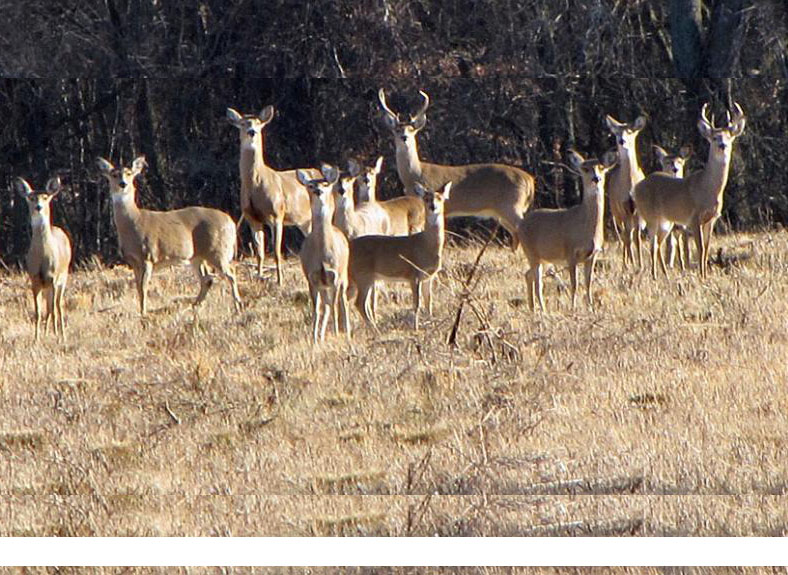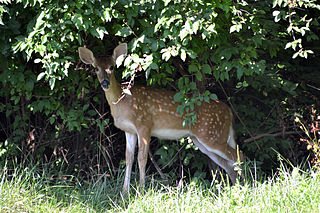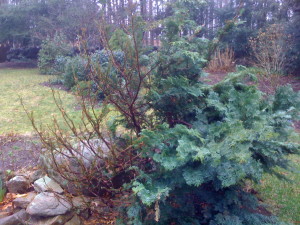A hundred years ago, the outer suburbs of major cities were mostly farmland and cleared of trees, and there were very few deer. But over time the farms receded and the land was turned over to housing developments. Some of the land was set aside for open space and the woods have returned. Today the woods have matured and provide food and cover for deer. It is an excellent habitat with few predators. Across the country suburban landscapers and plant care companies have struggled to protect their customers’ expensive landscaping from hungry deer.
Home Sweet Home
These woodlands have matured, creating the perfect home in which deer can thrive — rich in food and cover and free of most predators (aside from coyotes and cars). But the main attraction for deer is found in the form of acorns and other nuts. The creatures consume large quantities of acorns and other nuts in the fall to “carbo load,” creating fat reserves that they will burn to stay warm during the long, cold winter. These reserves provide sustenance when snow, ice and the dormant season leave other food scarce or hard to reach.
However, nut availability varies from year to year. And when winter food supplies decline, deer are more than happy to wander to favorite browsing places — our nearby yards where beautiful, lovingly tended landscaping serves up bountiful buffets of delicious edible plants. In fact, they increasingly turn to woody ornamental evergreens as a food source to survive.
The damage deer can do to expensive landscaping frustrates both the avid gardener and the new homeowner who is unaware of the local habitat and wildlife’s winter feeding problems. The plants they invested in for their enjoyment are quickly transformed into shabby shapes that look like something out of a Dr. Seuss children’s book. Deer cause millions of dollars in landscape damage every winter.
How to Protect Your Landscape from Deer
How can you protect your landscaping from winter deer damage? Let’s look at a few popular methods and their effectiveness.
- Build a fence
Generally, people try to seal off their yards first. The problem with this solution is that deer are excellent jumpers and can gracefully leap over an eight-foot barrier. You really need a 10- to 12-foot fence to keep them away using this method. Many communities, though, have zoning laws that restrict fence height.Maintenance is another major negative for fencing. I’ve often seen winter storm damage that knocks a hole in a section of fence. The deer easily get in and end up doing more damage in the fenced-in area because they can’t find a way out.And even if you do fence in your entire property, you better make sure you include the driveway entrance. Without an automatic gateway, the deer will find this entry an easy, welcoming path to your feast of greenery. Some homeowners fence in the backyard, but wind up sacrificing plants in the front. Obviously, fencing is complicated, expensive and not that effective. - Resistance can be futile
An alternative approach is to plant “deer-resistant” plants, a trend that’s grown steadily in Connecticut for the last 20 years. The problem is that there are a very limited number of truly deer-resistant evergreen trees and shrubs — basically spruce, boxwood and andromeda. Deer prefer to eat beautiful, tasty flowering shrubs and these “safer” landscaping choices may be a bit boring for you. - Creating monocultures: a new gardening problem
In addition, when we plant too many of the same plants and shrubs in a small, concentrated area, we create a monoculture that leads to other landscaping problems. For instance, after years of overplanting the beautiful, sculpted boxwood, boxwood leaf-miner infestation (insert pics) has become epidemic. It is now rare to see a boxwood hedge that is not infested with this destructive insect. Similarly, lacebug infestations can devastate andromeda. In both cases, trying to remedy one problem has created two: the deer remain, and now insect and disease problems have moved into the neighborhood.
- Repellents
What about deer repellent sprays? The problem with many repellents sold over-the-counter is that most of them deter by smell. However, freezing temperatures suppress smells rendering these “solutions” ineffective. Taste repellents are needed during winter months. In addition, most store bought repellents provide only a couple of weeks of protection. They need to be reapplied frequently and after every rainfall, and that can be a big challenge when you have to deal with freezing temperatures, snow and ice. - A Redding solution that works
During the winter, only an extremely strong and long lasting taste deterrent can effectively keep a hungry deer herd from devastating your plants and shrubs. Redding Nursery has been protecting Fairfield County landscaping for nearly 35 years with a professional-strength taste deterrent, DeerPro™ Winter Animal Repellent. Its superior sticking agent means that one spray in the fall will protect plants all winter and into April. This repellent is registered with the EPA and is applied by your local licensed professional. It will not hurt people, pets, plants — or the deer. It will just keep them from using your expensive landscaping as their winter banquet. Even starving deer will not eat plants treated with DeerPro™.DeerPro™, as an added bonus, also serves as an anti-transpirant, which protects evergreens from winter burn damage. No more winter damaged, brown and shriveled leaves in the spring.
* * *
Winter is coming, and so are the deer, so it’s time to take the surest step to protect your cherished landscape plantings. If you haven’t taken a moment to sign up for our DeerPro™ service, you can register online at www.reddingnursery.com






Recent Comments